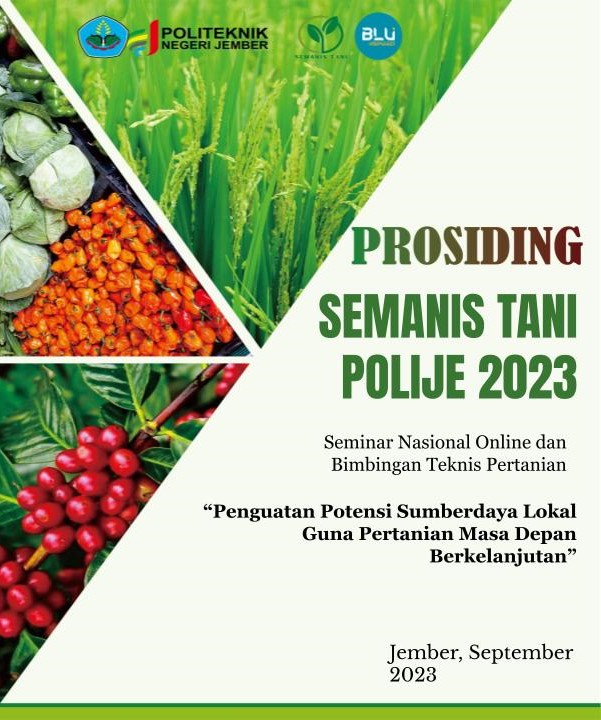Analisis Viabilitas Isolat Bakteri Penambat Nitrogen Azotobacter 33 pada Bahan Pembawa dan Suhu Penyimpanan yang Berbeda
DOI:
https://doi.org/10.25047/agropross.2023.500Kata Kunci:
Azotobacter, Carrier Media, Biofertilizer, ViabilityAbstrak
Azotobacter is a microorganism that enhances nitrogen availability for plants and has the potential to be used as a biofertilizer. Assessing the viability of microorganisms within a biofertilizer is crucial in determining its quality. The carrier medium and storage temperature influence the viability of Azotobacter bacteria. Therefore, this research aims to identify the most suitable carrier medium and storage temperature to promote the growth of Azotobacter as a biofertilizer before its field application. The study was conducted at the Soil and Environmental Biotechnology Laboratory, Faculty of Agriculture, Bogor Agricultural University. The viability of Azotobacter was tested using Zeolite and Molasses as carrier media, and stored at temperatures of 4°C and 27°C. The parameters observed were the bacterial population count on the 14th day and the 28th day after inoculation. The results showed that the Azotobacter viability analysis using Zeolite as the carrier medium, storage at 4°C resulted in a population count of 3.7 × 106 CFU/ml, in comparison stored at 27°C resulted in an increased population count of 5.3 × 107 CFU/ml on the 28th day after inoculation. On the other hand, the Azotobacter viability analysis using Molasses as the carrier medium, storage at 4°C the bacterial population count reached 8.5 × 108, and storage at 27°C resulted in a bacterial population count of 7.9 × 106 on the 28th day after inoculation. It can be concluded that both of carriers have a good ability. The viability of Azotobacter is better in Molasses as the carrier medium, with storage at 4°C and the viability of Azotobacter is optimal in Zeolite as the carrier medium, with storage at 27°C, maintaining a stable population density without a decrease in the population count.
Unduhan
Referensi
Alami, N. H., Duhita, C. K., Muslihatun, W., Kuswytasari, N. D., Zulaika, E., & Shovitri, M. (2018). Effect of Yeast Carrier Media with Azotobacter Addition as Biofertilizer Against Growth and Productivity of Mustard (Brassica juncea L.). IOP Conf. Ser.: Earth Environ. doi:10.1088/1755-1315/197/1/012001
El-Fattah, D. A., Eweda, W. E., Zayed, M. S., & Hassanein, M. K. (2013). Effect of carrier materials, sterilization method, and storage temperature on survival and biological activities of Azotobacter chroococcum inoculant. Annals of Agricultural Sciences. 52(2) 111-118. doi:https://doi.org/10.1016/j.aoas.2013.07.001
Hindersah R dan Pratiwi E. 2021. Media Cair Berbasis Molase untuk Meningkatkan Viabilitas dan Produksi Eksopolisakarida Azotobacter. Jurnal Tanah dan Iklim. 45(1): 39-46 http://dx.doi.org/10.21082/jti.v45n1.2021.39-46
Mckane,L., and J. Kandel. 1998. Microbiology, Essentials and Applications. 2nded. McGraw, Inc. Philadelphia.
Keputusan Menteri pertanian nomor 261 tahun 2019. Persyaratan teknis minimal pupuk organik, pupuk hayati, dan pembenahan tanah. 1 april 2019. Kementrian pertanian republik Indonesia
Kerr, A. and K. Gibb. 1997. Bacteria and phytoplasma as plant parasities. In : Brown, J.F. and Olge(eds). Plant pathogens and plant disease. Australia plant pathology. Armidale.
Kizikaya, R. (2009). Nitrogen Fixation Capacity of Azotobacter spp. Strains Isolated from Soil in Different Ecosystems and Relationship Between Them and The Microbiological Properties of Soils. J Environ Biol. 30(1): 73-82.
Putri S. M., I. Anas, F. Hazra, A. Citraresmini. 2010. Viabilitas Inokulum dalam Bahan Pembawa Gambut, Kompos, Arang Batok dan Zeolit yang Disteril dengan Iradiasi Sinar Gamma Co- 60 dan Mesin Berkas Elektron. J. Tanah Link., 12(1):23-30
Rahmayani E, Ismiani S, Wilujeng E. D. I., Muslimah D. H., Rizqulloh M. N.. 2018. Karakterisasi dan Viabilitas Bakteri Pelarut Fosfat dalam Bahan Pembawa Kompos dan Zaolit. Jurnal Agrosins dan Teknologi.3(1): 31-38
Sandra, S., Ilyas, S., Malik, S., & Javaid, K. (2013). Compost Fertilizer Production From Sugar Press Mud (SPM). J Microbial Res. 3:20-27.
Salhia B. M.2013. The Effect of Azotobacter Chrococcumas Nitrogen Biofertilizer on The Growth and Yield of Cucumis Sativus (Thesis). botany: the islamic university gaza.
Syamsiah M,. 2014. Respon Pertumbuhan dan Produksi Tanaman Cabai Merah (Capsicum annum L) Terhadap Pemberian PGPR dari Akar Bamboo dan Urine Kelinci. J Ago. 4(2):109-114
V, K., kannapiran, E., & Harimuraleedharan. (2010). Azotobacter population in Rhizosphere and non-Rhizosphere sediments of tondi coast. international jourmal of biological technology. 1:63-65.
Wilujeng, E. D., Ismiani, S., & Adnan, M. R. (2022). respon pertumbuhan vegetatif tanaman jagung manais varietas SD3 IPB terhadap pemberian kombinasi NPK dan Pupuk Hayati Azotobacter. Gontor Agrotech Science Journal. 8(2):102-108. https://doi.org/10.21111/agrotech.v8i2.8481
Xu W, Liang L, Zhu M. 2015. Determination of sugars in molasses by HPLC following solid- phase extraction, Int J Food Prop. 18:(3):547-557.
Unduhan
Diterbitkan
Cara Mengutip
Terbitan
Bagian
Lisensi
Hak Cipta (c) 2023 Sri Ismiani, Elly Daru Ika Wilujeng

Artikel ini berlisensi Creative Commons Attribution 4.0 International License.
Hak cipta (Copyright) artikel yang dipublikasikan di Agropross : National Conference Proceedings of Agriculture dipegang oleh penulis (Copyright by Authors) di bawah Creative Commons Attribution 4.0 International License (CC-BY). Sehingga penulis tidak memerlukan perjanjian pengalihan hak cipta yang harus diserahkan kepada redaksi.






